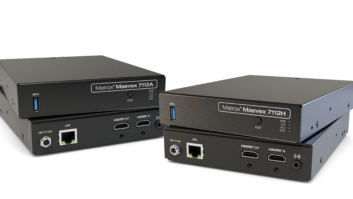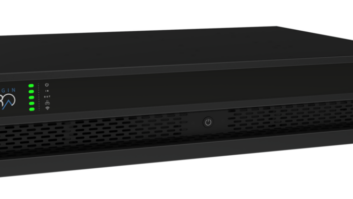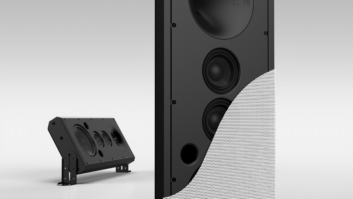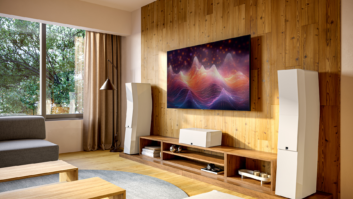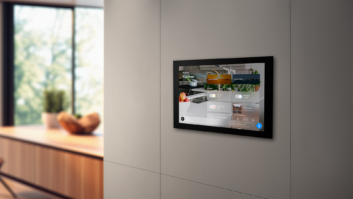One of the original developments in smart home technology was based around the remote–or more specifically, consolidating the operation of many home theater devices into one unified controller. Today, with touchpanels and far-field voice assistants galore, one would think that the days of the dedicated handheld remote were numbered. But there’s utility in familiarity, and the control interfaces to which we’ve always been accustomed are becoming mightier and more versatile than ever before.

Control4’s SR-260 gives users access to services such as voice assistants, Pandora, and Spotify, in addition to operating the functionality of the control system.
One reason for the enduring preference for remotes is their streamlined presentation of functions. “Handheld remote design ultimately is driven by ergonomics, ease of use, and removing complexity of a single room control,” said Michael Short, residential marketing manager at Crestron. “As homes become smarter and fully integrated end-to-end, the need to have the entire room at your fingertips is paramount. Due to the ever growing knowledge of consumers on smart homes, it’s also expected.”
Crestron’s TSR-302 remote aims to meet all of these requirements, with the combination of backlit tactile buttons and a 2.8-inch capacitive touchscreen, giving users the familiarity of a wand-style remote that can also operate all of the entertainment functions in the entire home, as well as things like heating, shading, and lighting. Setup of the TSR-302 is also made easier with Crestron’s Residential Studio Software, which aims to simplify remote programming. “Studio does the initial basic programming of each and every button for you, leaving the integrators to focus on the unique customer defined needs on that remote,” Short said. “It saves time but also allows the creative and complex programming to become the focus.”

The Crestron TSR-302 was created with ergonomics in mind, and with the company’s Residential Studio Software, allows integrators to save time on programming of basic functionality.
In addition to controlling connected home functionality beyond entertainment, Control4 looked at other trends to inform the development of its latest remote. “We’re seeing an increasing desire from customers for the ability to access their voice control systems, browse media libraries, and streaming audio/video services like Pandora or Spotify from their handheld remote,” said Paul Williams, vice president of product management, Control4. Its SR-260 remote accommodates these services, and can be broadly customized to meet a range of homeowner needs.
The 50-button SR-260 features an 8-bit color OLED display, with two quick access buttons–“watch” and “listen”–for quick control of common functions. Like Crestron’s remote, the SR-260 is designed to be simple to set up. “Programming processes are becoming even more simplistic as pro-level handheld remotes gain popularity in home automation systems,” Williams said. “At Control4, the programming process for handheld remotes has remained automatic and simple since its introduction.” Dealers set everything up in the company’s Composer Pro software, and then it’s “notoriously simple” to program.

Pro Control provides interoperability between its remotes and apps running on smartphones and tablets, providing a deeper level of control.
The ability for end users to customize their control experience by setting up scenes on their own has always been a cornerstone of Savant’s approach, and its Pro Remote facilitates this. It’s also made to be easier to set up within the control system, as well. “The Savant Pro Remote is initially set up by integrators using proprietary Blueprint configuration software, which automatically generates the control programming for each room and sends it to the remotes via Wi-Fi,” said Tim McInerney, director of product management at Savant. “Replacing a lost remote is as simple as putting the new one on the Wi-Fi network.”
Essentially the same device that the company began marketing directly to the consumers last year, the Pro Remote expands on its mainstream appeal with professional-level expandability to an entire home’s systems. “In order to deliver the most desirable smart home functionality and the finest user experience from a smart remote form factor, Savant combined the reliability of Wi-Fi with a high-resolution touchscreen and intuitive voice control commands in the Savant Pro Remote,” McInerney said. “The high-resolution touchscreen allows for a simple and elegant interface with fewer buttons preferred by today’s smart home consumer.” With hard buttons limited to basic volume/channel, navigation, and scrubbing, the focus of the Pro Remote is more on the touchscreen interface, especially in setting and recalling scenes, one of Savant’s hallmark features.

The Savant Pro Remote focuses on the touchscreen experience, with a high-resolution curved glass display.
Video intercoms and door stations are features that have been gaining traction in the consumer realm, driving increased interest in smart homes in the process. URC’s staple wand-style remote, the TRC-1080, combines the ability to monitor security and door video via its 2-inch screen with a more traditional button-laden remote for professional-level whole-home control of up to 32 rooms of entertainment and smart technology. The remote, along with companion URC Total Control touchpanels such as the 7-inch TDC-7100 tabletop controller and TKP-7600 in-wall touchscreen, offer a wide range of options for controlling large homes full of technology.
Obviously, a project with 32 rooms isn’t something you’d want end users messing with; setting up a URC remote properly is a job for the pros, and the company is always looking to keep these installers on top of their game. “Out of necessity, programing has become more complex as homeowners, manufacturers, and integrators strive for seamless integration of the latest entertainment, lighting, safety, security, comfort, and convenience technology,” said Russ Hoffman, director of training and technical support. “URC integrators continually expand their knowledge of URC and third-party integration with a goal of delivering best-in-class control solutions for divergent products, including the popular IoT and Z-Wave devices… URC offers live training sessions, webinars, and extensive eLearning curriculum to support this custom programming evolution, including hands-on training with top third-party brands, system design consultation, and on-demand tech support.”
While the wand-style remote is still the most familiar interface for most people, things are beginning to shift in favor of the next generation of users–those who have grown up in a world of touchscreen phones and tablets. “That’s why we have looked at the mobile technology that users enjoy as part of their daily lives and applied that to our latest wireless interfaces,” said Mike Everett, vice president of global sales for RTI and Pro Control. “On the RTI side, these enhancements make using our handheld devices feel familiar and satisfying.” RTI’s newest remotes feature edge-to-edge touchscreens with gesture control, and its flagship T3x features haptic feedback, with a subtle vibration to confirm the user’s on-screen selection.

RTI has taken cues from users’ preferences in mobile devices, and the company’s top-end T3x features haptic feedback for on-screen selection confirmation.
Like URC’s multi-device approach, Pro Control recognizes that the best controller is one that’s handy. “Pro Control offers easy interoperability with smartphones and tablets, as well as the latest smart home trends,” Everett said. “For example, our iPro.8 remote gives users a companion handheld device when using our ProPanel app–letting them take full advantage of anytime/anywhere connectivity (app) while letting the remote take care of more convenient, onsite operation.”
On the back end of these solutions, RTI and Pro Control have ventured to give integrators the timesaving convenience of drag-and-drop programming, as well as the ability to customize to the highest degree, with the availability of driver development programs to allow software engineering-savvy integrators to write their own drivers.
So what does the future look like for the wand remote? Everett feels that there are plusses and minuses to consider for any interface, so it’s best to accommodate as many preferences as possible.
“At one time, mobile apps were widely considered to be the beginning of the end for handheld interfaces, but over time, users have come to realize apps are not the complete solution,” Everett said. “Voice control is another amazing advance in the smart home, but it too has its drawbacks. Ultimately, a custom installer today needs to be able to integrate across the evolving technology landscape while still delivering the same control experience through the client’s chosen interface, be it handheld, mobile, wired, or voice.”
Matt Pruznick is senior editor for Residential Systems and Systems Contractor News. Follow him on Twitter @Pruznick.


